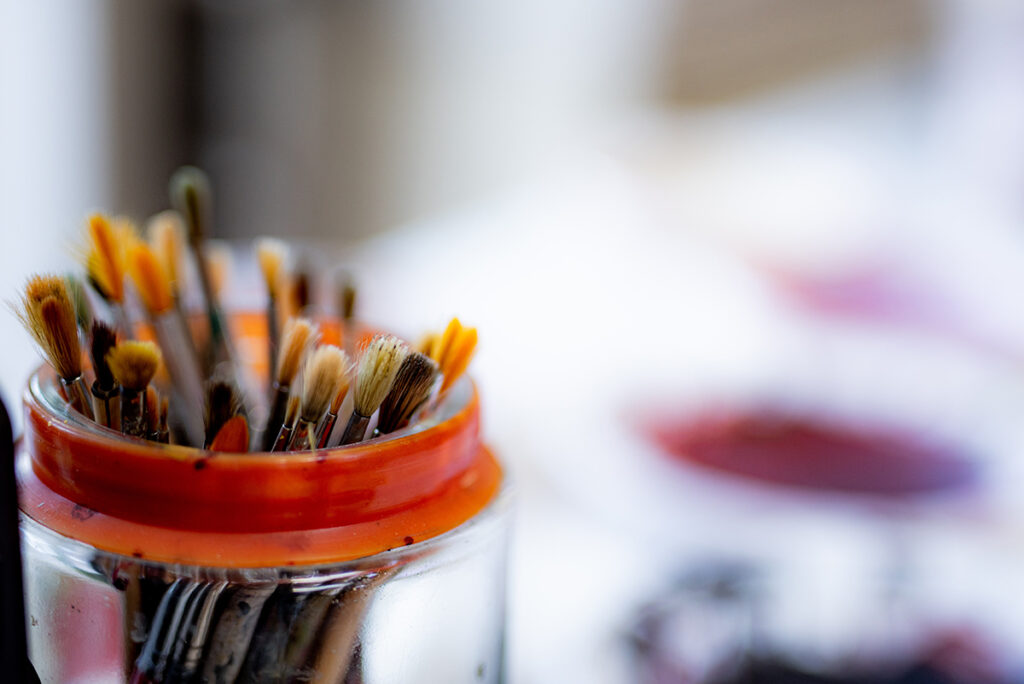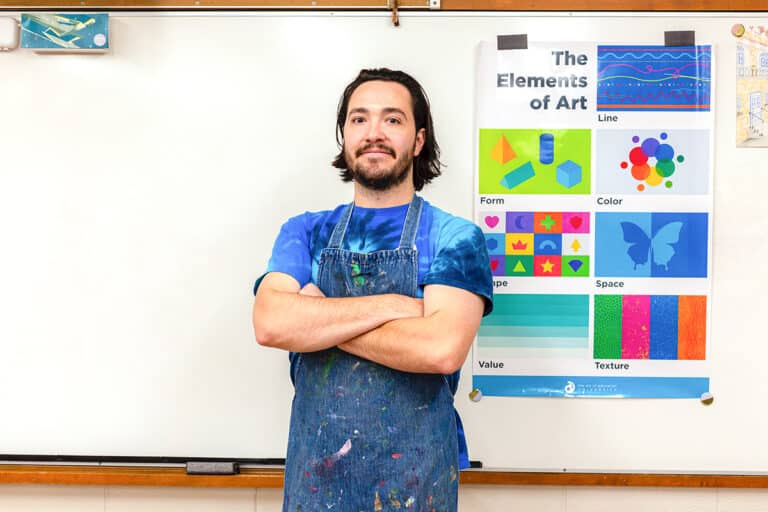As art educators, some of us find ourselves in districts with large art departments and plenty of collaboration. In contrast, you may be the only art teacher in your district. If this is the case, you may need to rely on a team that is outside your geographic location. Regardless of your department’s size, you can equip and empower one another to be successful and confident within your unique contexts. When you are supported, you can better support your students.
Whether you are a named leader or a committed member, consider these ten ways to equip and empower members of your art department.

1. Establish consistent methods of communication.
Communication is paramount. Set up a group text and email list to prompt consistent and quick communication. This can include sharing ideas, seeking advice, and encouraging a sense of belonging. Ask a team member for yellow paint if you run out, or share a successful student art piece with pride. You could even send a gif of Mona Lisa eating a hot dog on a Monday morning because if you need it, it must mean your team does too. We have grown accustomed to video calls and the possibilities they offer. Host a video check-in when meeting in person is not possible. Or go “old-school”—never underestimate the power of an impromptu personal handwritten note. Communication, whether virtual or in-person, makes us feel like we are a part of something that matters.

2. Encourage vulnerability by asking for help.
Typically, we only show the most successful student outcomes during presentations or social media posts. But there are plenty of times when things don’t go right and we need to ask for help. Encourage vulnerability with your fellow art educators. Share when things don’t go well and ask for potential solutions. When one individual speaks up and sees the team as a resource, others will do the same. If you are going to reach out for help, be sure to consider the advice of your colleagues instead of quickly dismissing their suggestions. Otherwise, specify that you need to vent. If you just need to spill a frustration, tell your team, “Please just listen; I don’t need you to fix it.” We can be better active listeners when we aren’t listening to respond.
3. Ask, “What do you need?”
It is easy to make assumptions about others and what they need. For departmental supports, empower your fellow teammates to speak up by asking, “What do you need?” It is a simple question that can change the course of your department’s climate and your team’s instructional practices. Use a survey to solicit responses to the question or have an in-person collaborative conversation. Then, seek out members of the department who can help fill those needs.

4. Set team norms.
Many successful businesses and schools establish staff norms and statements that get to the core of their mission and vision. Norm statements are actionable and keep a team focused on common goals. Have you set norms for your department?
Use the following questions as a guide as you compose your norms:
- What is our school’s mission?
- What is our department’s purpose?
- What do we want for our students?
- What are our priorities for the year?
- How do we want our team members to feel?
By starting with these questions, your department can focus on and prioritize what actions to take next. To make it easier to remember and follow your norms, include them on your department meeting agendas or group emails. Use these statements to drive future professional development practices.

5. Celebrate your teammates.
We all like to be recognized for our hard work. It matters even more when the person doing the celebrating is a fellow teammate who knows you. When you observe something extraordinary a colleague has done, share it with your team. You may find it uncomfortable to openly share your own successes but it can be a learning opportunity for others or a morale booster for all.
One routine that works well for students and staff alike is the Rose, Thorn, and Bud check-in. Department members can draw a rose, a bloom, and a thorny stem and reflect on their rose (current successes), bud (new ideas), and thorny stem (current challenges). This practice prompts self-awareness while also providing an opportunity for team reflection. For more ideas about recognizing your fellow teachers, check out this article that is packed with fun and practical suggestions.

6. Get to know one another as individuals.
A department of art educators is made up of, well, art educators. We love a good source for cardboard and spending time with like-minded people. But we are also a lot more. There are many different identities and experiences within one art teacher team that may break the mold of the stereotypical art teacher. Getting to know one another as individuals goes a long way in empowering teammates to feel included and enthusiastic about their work. Much like how a first-grade teacher may begin their students’ day with a morning meeting, take time during professional meetings or social gatherings to allow everyone to check in and connect with one another.
In your next meeting or gathering, try building relationships based on Humans of New York. This phenomenon has an interviewer who asks big open-ended questions and then sits back to listen. Within your department, partner up and ask big questions of one another and then listen. The listener can nod, smile, and affirm—but never interrupt. It may feel uncomfortable, but wait for the sharer to continue to speak or ask follow-up questions if there is a lull. After about five minutes, the partners can switch roles. This practice will allow teachers to get to know each other personally.
As art teachers, we love art. Challenge your team to make a piece of artwork based on the interviews to share with the group. Sound like it would be rewarding for students? Give it a try with them too! Listen to episode 5 of The Art of SEL to hear more about conducting this practice with teachers and students.

7. Share your enthusiasm.
When you are excited about an article, an idea, or a resource—share it! If you are enthusiastic, it is safe to say others in your department will also want to share in your enthusiasm. Use your established lines of communication to include the team. Ask for their opinions or thoughts on how they could apply the new learning. This practical step of asking others to consider the resource can spark further discussion. What if they aren’t as excited about your newfound joy as you are? That’s totally fine. Seek to understand why they aren’t. Maybe their input will ground you in reality or further confirm why you believe in the ideas you shared.

8. Invite others to enter your instructional space.
You can learn a lot by seeing one another’s classrooms, carts, organizational methods, and drying racks full of student artwork. You grow even more when you observe each other teaching and interacting with students. Invite your team to your classroom for a meeting, a relaxed chat with snacks, or an informal mini-observation. By doing so, you can inspire others and gather feedback. It may feel a little bit like you are inviting a mother-in-law into your space as you hurriedly hide all your stuff in a closed cabinet, but remember that it is best when you are authentically yourself.

9. Commit to the team.
In a large department, it can be easy to hide or recede into the background. Commit to being engaged and to be a force for possibilities instead of a naysayer. Your commitment to the group can become contagious. If your team is small or non-existent, commit to finding a group of like-minded art educators to form your own professional learning community (PLC). This can be in-person with surrounding districts or virtually. Pledge to share and engage with these educators regularly so you can build firm connections and relationships.
10. Have fun!
Spending time with a team of art teachers should be fun! Unfortunately, the fun doesn’t happen on its own; you must first decide to make the experience enjoyable and then plan for it to happen. Door prizes, drawing challenges, digital trivia, gift exchanges, and art field trips are just a few possibilities to make your team-building experience worthwhile and memorable.

Each new school year has its challenges, but having a committed team by your side can make it manageable and even thrilling. We all want a group that empowers and equips its members for success. This includes allowing opportunities for vulnerability so that everyone can share their perspective and expertise. There is much to learn from our fellow art teachers when we see each other as inspirational resources.
Check out the following PRO Packs to grow more in your leadership:
- Planning In-Person Professional Development
- Making the Most of Your PLC
- Providing Personalized Professional Development
- Building Leadership Skills as an Art Educator
What do you want someone to feel when they join your team?
Consider the members of your team. What roles do they fill?
How can you encourage someone in your department to speak up?
Magazine articles and podcasts are opinions of professional education contributors and do not necessarily represent the position of the Art of Education University (AOEU) or its academic offerings. Contributors use terms in the way they are most often talked about in the scope of their educational experiences.





